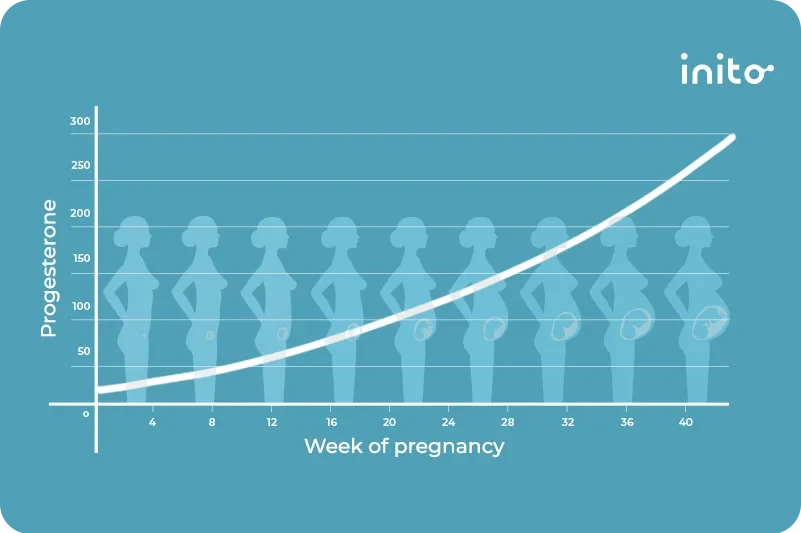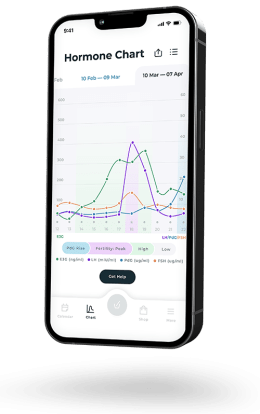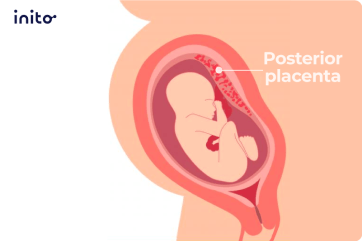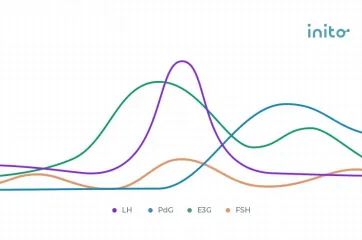Content table
Wondering if your progesterone levels are on point for pregnancy? We get it!
Progesterone is a hormone that can make or break your pregnancy. It thickens your endometrium to nourish your developing baby.
But it also prevents uterine contractions, reducing the risk of adverse pregnancy outcomes like miscarriage and preterm birth.
While pregnant, progesterone levels are meant to rise gradually from week to week. If they are low, it can be a warning that something’s amiss.
In this article, we’ll cover what normal progesterone levels in early pregnancy look like by week. We’ll also reveal what can cause progesterone levels to get out of range.
But first, let’s quickly recap how progesterone affects your monthly cycle.
Takeaways
- Progesterone helps regulate your menstrual cycle and plays a vital role in pregnancy.
- It thickens the uterus lining so a fertilized egg can attach and develop.
- For the first 10 weeks of pregnancy, the corpus luteum is in charge of progesterone production. After that, the placenta takes over.
- There is a higher risk of miscarriage and preterm birth if your progesterone is low.
- Progesterone levels rise throughout pregnancy and peak in the third trimester.
- Your weekly progesterone levels can offer clues about how your pregnancy is progressing.
How do progesterone levels change during your menstrual cycle?
Progesterone stays low during the first half of your menstrual cycle (follicular phase). But once you ovulate, that all changes.
After ovulation, the empty follicle that releases the egg becomes the corpus luteum. This temporary organ produces progesterone to thicken your uterine lining. This makes your uterus a cozy home so a fertilized egg can attach.
Thanks to the corpus luteum, your progesterone rises during the luteal phase after ovulation. If sperm fertilizes an egg and you become pregnant, progesterone keeps rising.
But if an egg isn’t fertilized, the corpus luteum breaks down. This causes progesterone to drop, prompting the start of your period.
Here’s a peek at normal progesterone levels by cycle phase:
Menstrual cycle phase | Serum progesterone levels (ng/mL) | Urine progesterone metabolite PdG levels (ug/mL) |
Follicular phase | 0.1 to 0.7 ng/mL | 0 to 3 ug/mL |
Luteal phase | 2 to 25 ng/mL | 6 to 40 ug/mL |
As you can see, your progesterone levels shoot up quite a bit in the luteal phase. But that’s nothing compared to what they do during pregnancy!

See how your hormone chart might look like!
Answer some questions to help us provide you a free personalized hormone chart customized to your hormonal health and conditions
Progesterone trends in pregnancy
Before looking at trends, let’s cover how pregnancy is calculated in the first place.
Your pregnancy timeline is based on your last menstrual period. The first day of your last period is considered day 1 of pregnancy. At this point, you haven’t conceived yet, so it’s a bit confusing!
Due to this, progesterone levels before ovulation (weeks 1-2) are the same whether you’re pregnant or not. Progesterone ranges in the luteal phase (weeks 3-4) are the same for pregnant and non-pregnant women as well.
That said, your progesterone should ideally be over 10 ng/mL in the mid-luteal phase if you’re TTC (Trying To Conceive). For non-pregnant women, anything over 7 ng/mL at the mid-luteal peak is normal.
Once pregnant, the corpus luteum secretes progesterone until about the 10th week of pregnancy. By around 10-12 weeks, the placenta takes over progesterone production entirely.
This transition is known as the ‘luteal-placental shift,’ and it occurs between 6 and 8 weeks of gestation.
As with all things in pregnancy, timing is everything.
Evidence shows that progesterone levels may dip too much if the luteal-placental shift happens too early (before 7 weeks). This may increase the risk of early pregnancy loss.
But if the placenta takes over after 9 weeks, it increases your chances of a successful pregnancy.
Progesterone levels by week
So what should your progesterone levels look like during pregnancy? Let’s break it down week by week…
Weeks 1-13 (first trimester)
Normal serum progesterone levels in the first trimester (until week 13) are between 10 and 44 ng/mL (or 31.8 and 139.9 nmol/L).
As mentioned, progesterone levels are roughly the same for pregnant and non-pregnant women in the first 4 weeks of pregnancy.
The chart below is based on an average 28-day cycle:
Week of pregnancy | Normal serum progesterone levels (ng/mL) | Normal serum progesterone levels (nmol/L) |
Week 1 | 0.1 to 0.7 ng/mL | 0.3 to 2.2 nmol/L |
Week 2 | 0.1 t 0.7 ng/mL | 0.3 to 2.2 nmol/L |
Week 3 | 2 to 25 ng/mL | 6.4 to 79.5 nmol/L |
Week 4 | 2 to 25 ng/mL | 6.4 to 79.5 nmol/L |
One study looked at progesterone levels for 590 women with low-risk pregnancies. They found that progesterone levels dip in the luteal-placental shift.
During the transition, serum progesterone levels declined after week 5, reaching their lowest point at week 7. After that, they rise.
Check out the progesterone levels chart below and you’ll see what we mean:
Week of pregnancy | Mean serum progesterone levels in nmol/L (2.5th to 97.5th percentile) | Mean serum progesterone in ng/mL (2.5th to 97.5th percentile) |
Week 5 | 75.0 nmol/L (35.8 – 139.5) | 23.6 ng/mL (11.3 – 43.9) |
Week 6 | 66.9 nmol/L (31.3 – 124.4) | 21.0 ng/mL (9.8 – 39.1) |
Week 7 | 63.4 nmol/L (32.9 – 103.5) | 19.9 ng/mL (10.3 – 32.5) |
Week 8 | 67.7 nmol/L (34.6 – 127.2) | 21.3 ng/mL (10.9 – 40.0) |
Week 9 | 78.9 nmol/L (40.3 – 158.6) | 24.5 ng/mL (12.7 – 49.9) |
Another study measured progesterone levels among women between the 5th and 13th weeks of pregnancy. They found that women who had a spontaneous miscarriage before the 16th week had lower progesterone levels between weeks 5 to 13.
Their progesterone levels also didn’t rise as much compared to women who went on to have a healthy pregnancy. Women who miscarried had progesterone levels about 10 nmol/L lower than other women.
Weeks 14-27 (second trimester) & Week 28 to term (third trimester)
By the second trimester, the placenta is in charge of progesterone production entirely.
Progesterone levels continue to rise before peaking in the third trimester. This helps the fetus grow, prepares the breasts for milk production, and helps prevent preterm labor.
To paint a picture, here are normal progesterone ranges for the second and third trimesters:
Trimester of pregnancy | Serum progesterone levels (nmol/L) | Serum progesterone levels (ng/mL) |
Second trimester (weeks 14 to 27) | 62 to 262 nmol/L | 19.5 to 82.5 ng/mL |
Third trimester (week 28 and up) | 206.7 to 922.2 nmol/L | 65 to 290 ng/mL |
How can monitoring progesterone support a healthy pregnancy?
Usually, hCG (human chorionic gonadotropin) is the go-to hormone doctors check to see how your pregnancy is progressing. In the first 6-7 weeks of pregnancy, hCG levels double every 48 hours.
If it doesn’t, that’s seen as a warning that the pregnancy may not be viable. Yet research shows this isn’t always the case.
For about 15% of women who go on to have healthy pregnancies, hCG levels rise by less than 66% over 48 hours. So clearly, hCG alone doesn’t give the full picture.
Enter progesterone. Progesterone levels can serve as an extra diagnostic tool to assess your pregnancy’s viability.
One study found that hCG was 44.7% accurate at predicting the risk of future miscarriage on its own. However, when the hCG and progesterone combo was used, the accuracy shot up to 83.3%.
What if my progesterone levels are too low?
Low progesterone levels during pregnancy are linked with the following:
Ectopic pregnancy
This is when the fertilized egg goes awry and implants outside the uterus (usually in a fallopian tube). Sadly, ectopic pregnancies are not viable and require prompt treatment. When left untreated, they can be life-threatening.
Vaginal ultrasounds are typically used to diagnose ectopic pregnancies. But they can’t always detect them in the first weeks of pregnancy (week 4-6). Assessing hCG and progesterone levels can help with diagnosis.
Luteal phase defects
Also known as luteal phase deficiency, this is when the endometrium doesn’t develop properly. This makes it difficult for the embryo to implant and grow.
Luteal phase defects are due to low progesterone or the body not responding to progesterone as it should.
Learn more: Your Guide to Luteal Phase Defects
Miscarriage or threatened miscarriage
As mentioned, low progesterone increases the risk of miscarriage. But progesterone can even help predict the outcome of threatened miscarriages.
Threatened miscarriages happen in the first 20 weeks of pregnancy. In a threatened miscarriage, vaginal bleeding occurs, but the cervix stays closed. Usually, the pregnancy keeps progressing. But 25% of the time, they result in a spontaneous miscarriage.
One study checked progesterone levels for women having a threatened miscarriage. They found that in weeks 6 to 10 when the progesterone level fell under 35 nmol/L, there was a greater chance of spontaneous miscarriage.
Learn More: How Progesterone Helps to Prevent Miscarriage
If you suspect your progesterone is low, it’s crucial to talk with your doctor. They can help you figure out what’s causing it, determine if supplements are needed, and offer tips to support ongoing pregnancy.
Learn More: How to Increase Progesterone Levels?
What if my progesterone levels are too high?
First off, know this isn’t all that common.
That said, some scenarios can cause high progesterone:
Multiple pregnancies
Progesterone levels are higher when carrying twins, triplets, or quadruplets. This is totally normal if you’re carrying more than one baby!
Molar pregnancy
While rare, this is when an abnormality with the fertilized egg causes an abnormal cell mass to develop in the uterus. Molar pregnancies are linked with high hCG and progesterone levels.
High supplement doses
If you’re taking progesterone supplements, you’ll need to monitor your levels carefully. If your dosage is too high, you may end up with high progesterone levels.
Congenital adrenal hyperplasia
This rare genetic disease disrupts hormone production in the adrenal glands. It can cause hormones to get too high, or too low. It’s usually due to a deficiency in an enzyme (21-hydroxylase), which helps your adrenals make hormones.
Cancer of the adrenals or ovaries
Abnormal cell growth in the adrenals or ovaries may also lead to high progesterone.
Learn more: How Does Too Much Progesterone Affect Fertility and Pregnancy?
So, does everyone need to monitor their progesterone while pregnant?
No, not everyone.
But in certain situations, progesterone levels should be closely monitored, including:
- Women undergoing In Vitro Fertilization (IVF)
- Infertility patients receiving progesterone supplementation
- Women with a history of spontaneous miscarriages
If you’re pregnant and none of these apply to you, then monitoring your progesterone is optional.
Summing it up
Checking your progesterone levels isn’t necessary for all pregnancies. But in some cases, it should be closely monitored.
Progesterone levels rise throughout pregnancy, making your womb a nurturing environment for your growing baby. If your progesterone gets too low, your risk of preterm labor and miscarriage goes up.
Tracking your weekly progesterone levels is one way to monitor the health of your pregnancy. And to monitor it effectively, you can use the Inito Fertility Monitor.
Inito can track progesterone levels throughout your cycle. It measures PdG, a urine metabolite of progesterone, along with LH, FSH, and estrogen to give you a clear picture of your hormone levels.
Want to learn more about Inito? Try it!
Was this article helpful?
- Progesterone – Health Encyclopedia – University of Rochester Medical Center
- https://www.sciencedirect.com/science/article/abs/pii/B9781416049074000322
- Hormones in pregnancy – PMC
- The timing of placental competence in pregnancy after oocyte donation
- Gestational age-specific normative values and determinants of serum progesterone through the first trimester of pregnancy | Scientific Reports
- Serum progesterone distribution in normal pregnancies compared to pregnancies complicated by threatened miscarriage from 5 to 13 weeks gestation: a prospective cohort study
- Early Maternal Serum β-human Chorionic Gonadotropin Measurements After ICSI in the Prediction of Long-term Pregnancy Outcomes: A Retrospective Cohort Analysis – PMC
- Chorionic Gonadotropin Beta Subunit – an overview | ScienceDirect Topics
- Validation of serum progesterone <35nmol/L as a predictor of miscarriage among women with threatened miscarriage – PMC
- Congenital Adrenal Hyperplasia – StatPearls – NCBI Bookshelf
















